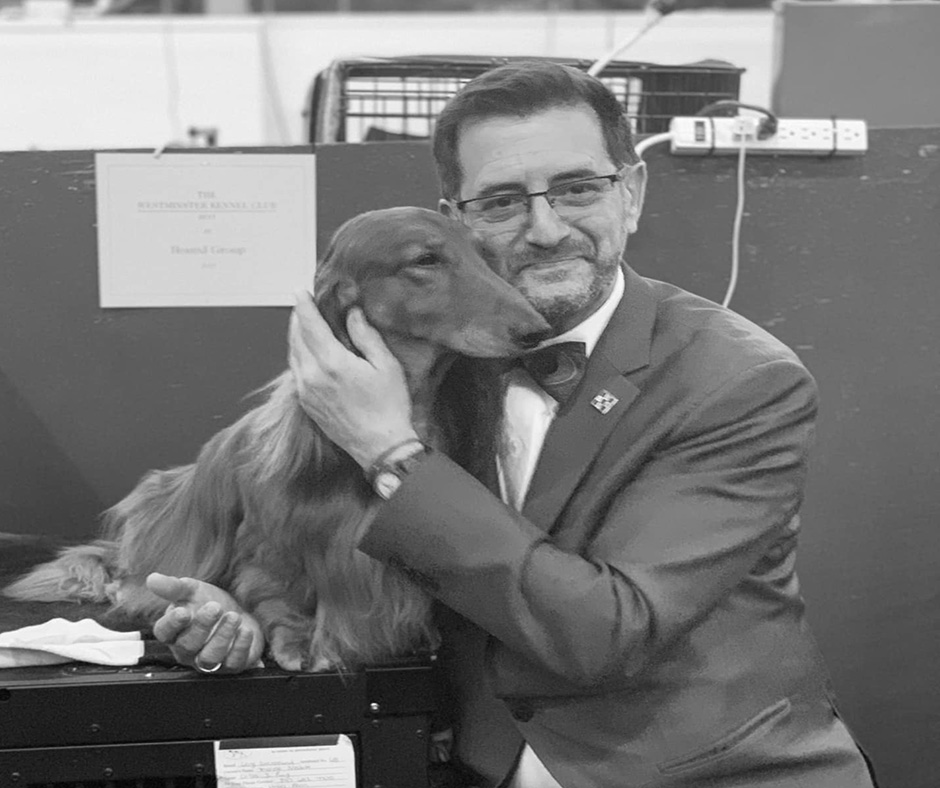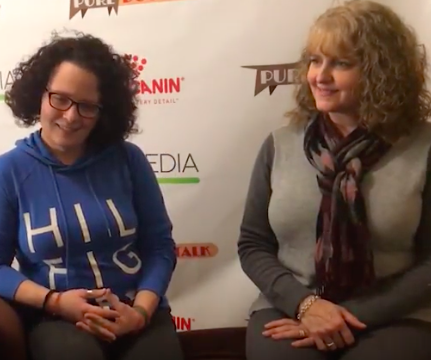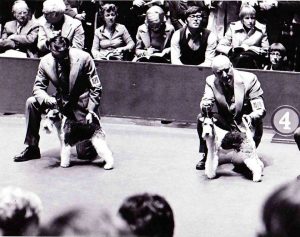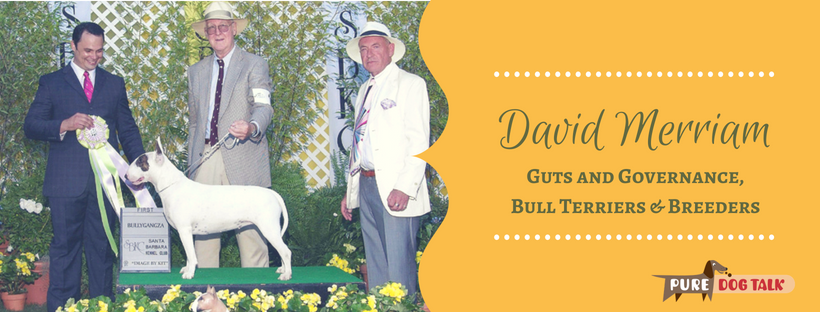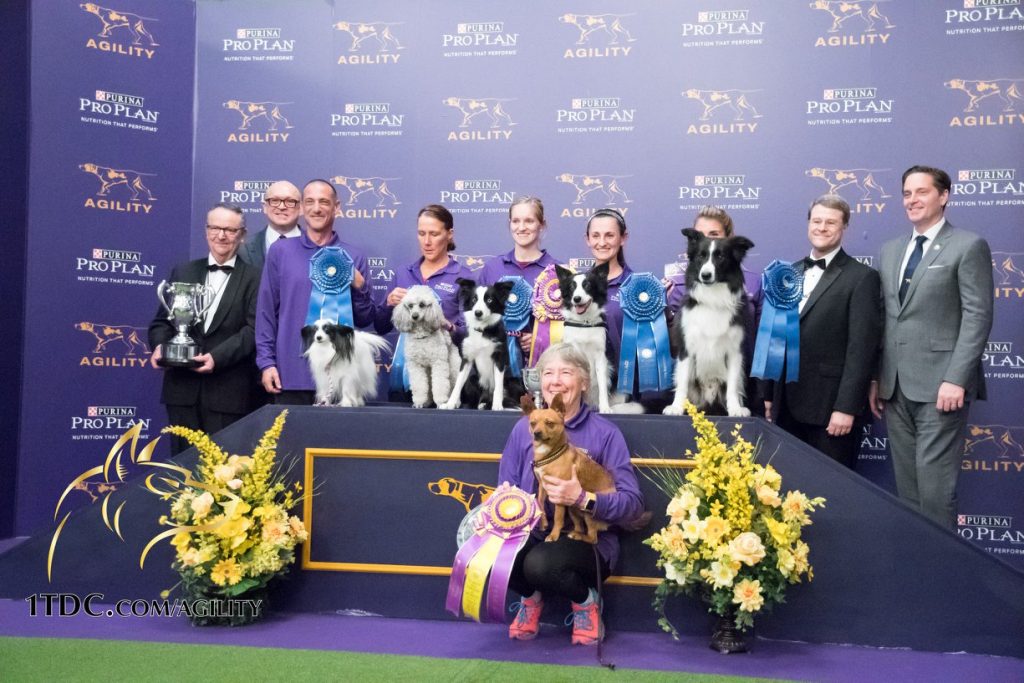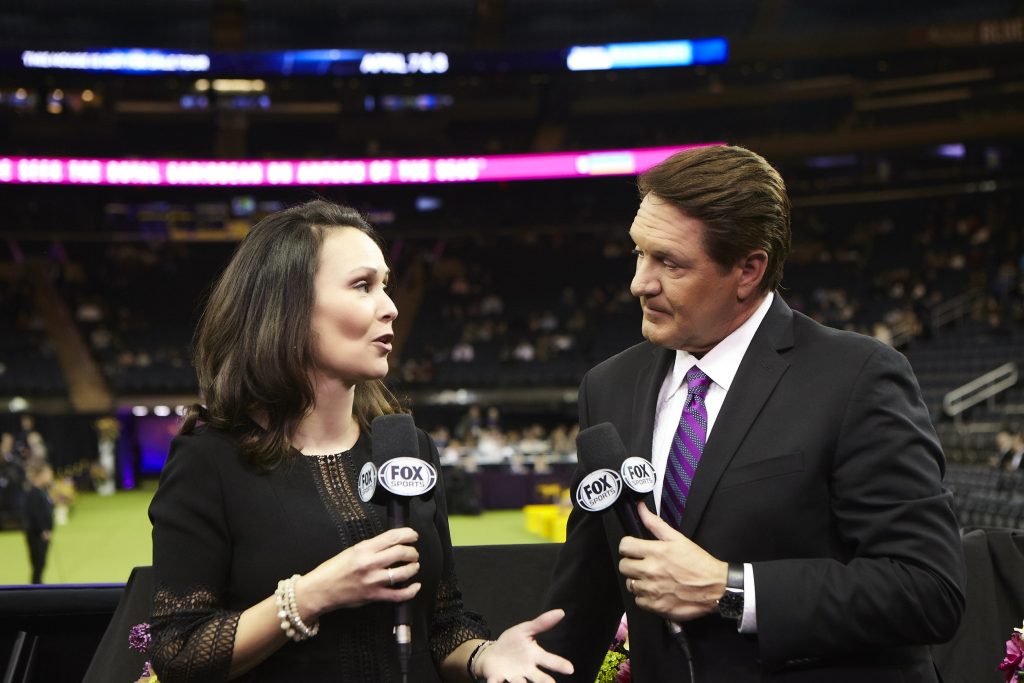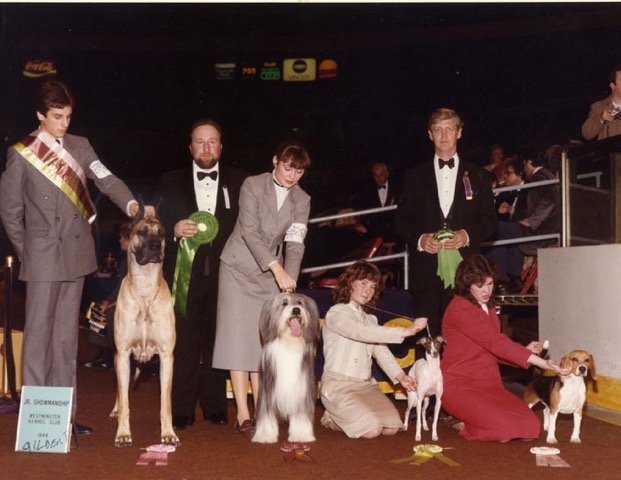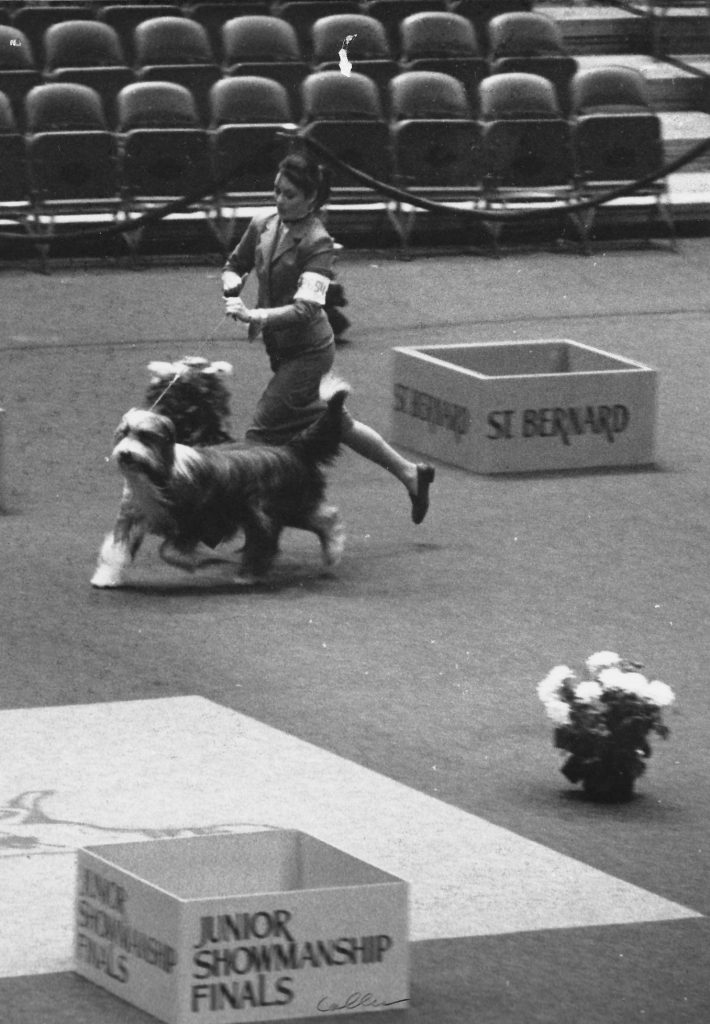264 — Carlos Puig: All About Dachshunds and Getting in a Dog’s Head
Carlos Puig: All About Dachshunds and Getting in a Dog’s Head

Handler Carlos Puig and Longhaired Dachshund, Burns, Hound group winner at the 2019 Westminster Kennel Club.
Anyone who watched the joy with which the Longhaired Dachshund, Burns, showed at Westminster Kennel Club last week, or loves Dachshunds in general, will appreciate this talk with handler Carlos Puig.
A Dachshund fancier, breeder and handler for 45 years, Puig brings out the pure spirit in each of his charges. How and why this “jazz pianist” of dog handlers does this is an amazing story. His encyclopedic knowledge of the Dachshund breed is equally impressive.
“(Dachshunds) are almost like an accordion,” Puig said. “They are very flexible because they had to be able to get in the badger den, maneuver underground and then back out.”
Dual Champion Does it All
In fact Burns, GCHP DC WALMAR-SOLO’S OMG SL JE, is believed to be the first dual champion of any breed to win a group at Westminster Kennel Club. Puig is proud that Burns has been successful in both field trials and earth dog events, proving that great show dogs can still do the work for which they were bred.
While Standard and Miniature Dachshunds have the same breed standard, Puig notes there are distinct differences between the varieties of coats and sizes. Smooths are the guard dogs, Longs are the snugglers and Wires will make you laugh, he said. And while Standards were bred for hunting badger, Minis are more about speed and were bred specifically for hunting rabbits and flushing deer.
“Back in the day (as the breed was developed in the 1800s) the best wires were standard longhairs bred to Dandie Dinmonts,” Puig said. “Which is why you still see lighter color hair on the heads of some Wire Dachshunds.”
Dog Handler as “Jazz Pianist”
Puig began his journey as a shy 11-year-old, house sitting for a neighbor who owned and showed Great Danes and later Dachshunds. He helped socialize puppies and groomed dogs for the owners while they were at shows because his parents were very protective and wouldn’t let him travel out of state.
“I learned to communicate with dogs before I learned to communicate with people,” Puig said. “I am grateful to the dogs…. they literally saved my life. I feed off the dog’s personality. You gotta get in their heads. I hate the robot dogs. There are never two dogs that are exactly alike. If you can’t pick up on that, you’ll get nowhere. I’m fortunate I started with Dachshunds, because I had to convince them they were doing what they wanted to do, not what I was making them do.”
262 — Will Alexander on Grooming, Handling and Heroes
Will Alexander on Grooming, Handling and Heroes
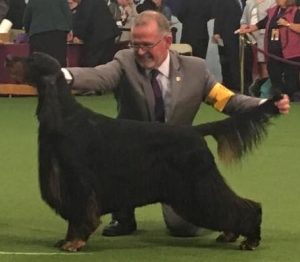
Will Alexander winning BOB in Gordon Setters at Westminster Kennel Club this week.
Canadian dog handling legend, Will Alexander, shares his memories, his handling tips and grooming tools that have brought him significant success in the last 25 years.
“My heroes were people like George Alston,” Alexander said. “He basically taught me to trim Irish Setters over the phone.”
“I always wanted to be a handler, but before embarking on a handling career I worked for Garry MacDonald in Canada, and for Bobby Stebbins in the States,” Alexander said.
Carving the picture
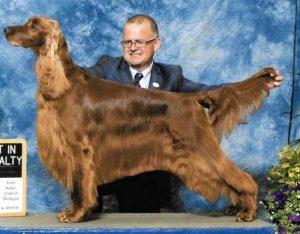
Will Alexander grew up with Irish Setters and learned from George Alston, over the phone, how to trim them.
Grooming is not a recipe, Alexander noted. Every dog is different. Famous for his meticulous grooming of setters particularly, Alexander describes a process to “build a shell around the dog” when trimming the back coat. He works with a stripping knife, his fingers, a grooming stone and, the most important piece, a bristle brush to bring up the oils in the coat.
Attention to detail
“I hate it when I hear “Oh, they won because they are so and so… well, they didn’t just grow up and they were so and so… they had to work hard to become so and so,” Alexander said. “It’s hard work. For every 15 minutes of fame there are 23 hrs 45 minutes working on your dog. It’s not age, it’s mileage.”
Tips of the trade
- Think in slow motion. In real time you’re doing exactly the right speed.
“When Miss P won the group at the Garden, George Alston called and yelled at me that I had gone too fast on the down and back. It was terrifying!”
- Attention to detail.
“I like to sit and watch the ring, pretend I’m in there already, making my mistakes in my head so I don’t make them in the ring.”
- “Old fashioned” isn’t bad
“I have a mind’s eye picture of the dogs. So much of type is in how they move, how they carry themselves,” Alexander said. “We need to be preserving the breeds not ‘improving’ them.”
Dream Best in Show Lineup
- English Springer Spaniel Ch. Salilyn’s Condor
- Borzoi Ch. Kishniga’s Desert Song
- Doberman Pinscher Ch. Brunswig’s Cryptonite
- Wire Fox Terrer ch galsul excellence
- Pekingese Ch. Wendessa Crown Prince
- Standard Poodle Ch. Rimskittle Ruffian
- German Shepherd Dog Ch Altana’s Mystique
BIS to Robert the Springer
For more information, videos, the book and more, visit http://www.doghandlingtips.com/
Allison & Laura Handicap the Line Up at Westminster Kennel Club
Special: Allison & Laura Handicap the Line Up at Westminster Kennel Club
Special edition!! Allison & Laura jam on the Westminster Kennel Club show, the fabulous contenders and who may or may not rise to the top of the pack. Las Vegas oddsmakers have occasionally offered up a “line” on the Garden. But those are not Dog Show Divas! Pure Dog Talk brings you two of the sport’s long-time observers with input on who stands a good chance in the green carpet final seven line up this year.
Whiskey the Whippet and King the Wire Fox Terrier are high on the list of the potential winners. The Havanese, Bono, is peaking at the right time but could be pushed by Treasure, the Papillion. The Border Collie, Slick and the new German Shepherd Dog, Tony, are set to duke it out in the herding group. A surprise appearance from Elsa the Old English Sheepdog could upset that applecart.
Breed judging on Tuesday will make or break a lot of the group judging. Will Bean the Sussex Spaniel who won the group last year come back and play in BIS again? Or will the brand new English Setter, Penny, come on strong? Sporting is in play!
Working group is being judged by Jimmy Moses. Questions about what Doberman will get to the group and what Boxer will win the breed have a lot to do with which dog could win the group. Once again, up in the air. Allison says, “Jimmy Moses will pick a solid dog, but what’s he gonna get to work with?”
Jim Reynolds to Christine Erickson to Peter Green. Is this the fairy tale line up for King and Gabriel?
Allison is going all Ws…. She’s putting her line up as BIS to the Wire Fox Terrier and RBIS to the Whippet. Laura has her heart and her money, long odds, on the Wire Fox Terrier and the Havanese as RBIS.
Check out the Dog Show Divas with the best line on the best in show line up at Westminster Kennel Club on Pure Dog Talk! Vegas got nothin’ on us, baby!
238 — The friendships and journeys of a successful owner-handler
Sealyham Terrier owner-handler at the 2018 Westminster Kennel Club
Olga Forlicz and Leslie Jaseph, Sealyham Terriers breeders, share stories about the international friendships and journeys of a successful breeder owner-handler.
Details matter
Jaseph shares her experience showing in the hyper competitive East Coast terrier groups, many of which are dominated by top professional handlers.
“You have to go in the ring with your dog trained and prepared like any other person in the ring,” Jaseph said. “You have to understand preparation and trimming. You can’t make an excuse. You and your dog have to be prepared.”
No excuses
Jaseph’s highly successful bitch was entered at Westminster Kennel Club, but she didn’t bring her because she wasn’t quite back to top condition from her litter of puppies.
“You have to have high standards,” Jaseph said. “Never bring your dog out unless you feel it can win.”
US versus Europe
Forlicz, who lives in Poland and is the breeder of Jaseph’s competitive bitch, compared European and American shows. She said that the general level of grooming and overall presentation is much higher here in the US.
“In Europe we have famous breeders, but not as many professional handlers,” Forlicz said. “It is maybe easier for the average person to compete at a high level.”
Forlicz added that while there are more shows in the US, Entries are typically much larger in Europe.
International partnership
Jaseph approached Forlicz to purchase a dog because she was “looking for something tightly bred, that phenotypically was a good match for anything in the US.”
Breeders should “Get out your ruler and measure the dog,” Jaseph said. “Compare it to standard, break it down.” She also noted that within style variations, balance is the key in the breed.
Her general assessment of the breed, although it is numerically threatened worldwide, is that overall coats and movement are good. Her observation is that breeders should pay attention to tailsets and the length and strength of heads.
The full-length video interview also is available at the Pure Dog Talk YouTube channel, here: https://www.youtube.com/watch?v=6qr5CEfpFIk
218 – Legendary Dog Man Peter Green Brings History to Life
Peter Green riffs on great dogs, great rivalries and great memories
Join a wonderful conversation between legendary dog man Peter Green and his former apprentice Robert Paust, now an AKC judge in his own right. The two old friends reminisce about great dogs of the past, great wins, great friendships and great rivalries.
Green’s Welshman brogue has blurred but not faded from his voice in the 50-plus years he’s been working with dogs in the U.S. Starting in dogs showing Welsh Terriers with his uncle, Green began his career in the States in 1963. As was common at the time, he worked as a private handler for a prominent kennel to learn the business.
WKC BIS with the Lakeland
His professional handling career kicked in to high gear after he won Best in Show at Westminster Kennel Club with the great Lakeland Terrier, Ch. Stingray of Derryabah, in 1968. In a career that spanned 40 years as one of the pre-eminent professional handlers in the country, Green piloted dogs to the big ribbon at the Garden four times. He is slated to judge BIS on the green carpet this coming February.
Green was very definite on his favorite dog of all time. In all the dogs, in all the years, the Wire Fox Terrier, Ch. Sunnybrook Spot On was his choice without hesitation.
Spot On vs Dominator and other great battles
Peter Green, left, with Spot on and George Ward, right, with Dominator in one of the most-watched rivalries of the era.
Listening to Green flashback to the tremendous competition with his friend and rival George Ward, showing Spot On’s son, Ch Aryee’s Dominator, is a rush. Even as he’s reminiscing, Green is teaching without even thinking about it. He talks about how he showcased his dog’s movement in this high-stakes competition.
Dog show drama was alive and well, even in the “good old days,” according to Green. Good natured rivalries, and even those that weren’t so pleasant, behind the scenes stories, flaring tempers and redemption all flow from his memories.
Enjoy this priceless window into history.
184 – Merriam: Guts and Governance, the Bull Terrier, Breeders
“Guts and Governance” of purebred dogs, the Bull Terrier, and Breeders
Hon. David Merriam was given a White Bull Terrier in 1953. “Gigi” was the gift that keeps on giving, starting a 65-year love affair with the breed and purebred dogs.
When Merriam was given Gigi, he had some Collies. “They were not very good collies, conformation-wise,” he said. “Then I was given this bull terrier and she won quite a bit,” he added, in regard to why he’d chosen the Bull Terrier breed. “And winning is better than losing. They grow on you. You become very chauvinistic about them.”
Judging Similarities in Court or in the Ring
Merriam was a trial court judge in Southern California for 20 years and president of the Golden State Bull Terrier Club while still in law school.
“There’s a similarity in judging law cases and dog shows,” said Merriam, who presided over Best in Show at Westminster Kennel Club in 2015. “Each has a standard. AKC has a standard for each breed. In the courts the standard is known as the law. In the courts you receive evidence… testimony or physical evidence. In a dog show the evidence is the dogs in front of you. What you see and feel and the application of the standard to those animals.”
History and Judging of Bull Terriers
The essence of the Bull Terrier is the head, Merriam noted. “It’s an egg-shaped head. It’s only commonly been found in the last 20 years or so. Heads have improved enormously. Alva Rosenberg said, ‘Close your eyes, put your hand on the head. It should feel like a velvet egg.’”
The breed was developed as the *white* bull terrier, Merriam said. “Those devoted to the White Bull Terrier thought the Colored dogs were mongrels,” he added. “It wasn’t until the late 1930s that the Colored Bull Terrier was imported to the US from England. There were huge fights within the bull terrier club and the American Kennel Club about recognition of the variety. “Colored (bull terrier) development was slow. It wasn’t until the ‘70s that the quality began to be developed,” he observed.
“It’s been a successful marriage,” Merriam said of the two varieties. He remarked on some problems associated with white bull terriers, including deafness and skin problems. Research by the BAER hearing test program showed that “(In) white to white (breedings), one-third of the litter would have some hearing deficiency. White to colored that went down to 6 percent.”
BTCA presented the information to breeders, who then found value in the Colored variety and began using them in breeding programs. “If you give competent breeders the tools and the information, they’ll help correct the situation,” Merriam said.
Guts and Governance
As a long-time AKC delegate and past Chairman of the Board of Directors, Merriam noted that the “guts” of the sport is at the level of the next dog show and the next breeding.
“The governance of it, whether in the delegate body or the Board of Directors, is of lesser interest to all the people here at the dog show,” Merriam said. “How many exhibitors or breeders read the minutes of the board meetings? They only become aware of those when a new regulation comes down.”
Calling himself a “traditionalist,” Merriam challenged some of the ideas and directions of the American Kennel Club.
“If I were king, I would divide the kennel club,” Merriam stated. “I would have the traditional part of conformation and field trials in one group and then I would have all of the other (companion events) in another group. … Each of the two organizations would have to support themselves.”
“The most important thing,” Merriam said in summary, “is that each breed has a coterie of outstanding breeders. They are what moves the breed ahead. Nothing that AKC does change that.”
We hope you enjoy this thought-provoking, challenging, and fascinating conversation with one of the legends of our sport.
169 – Jessica Ajoux Westminster KC Agility Champion Talks Form and Function
WKC AGILITY WINNER SHARES HER THOUGHTS
Jessica Ajoux and her Border Collie, Famous, won the WKC Master Agility Championship in February. She shares her insights on how a dog’s structure affects its performance on the agility course.
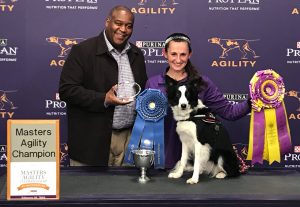
Jessica Ajoux and Border Collie, Famous, are the WKC Masters Agility Champions
PASSION FOR AGILITY STARTED EARLY
This February was her first time winning the prestigious WKC competition, but Ajoux started in the sport of agility as a teenager. Her mom drove her to her first classes and agility shows, which were scheduled around school and homework.
Watching an agility competition for the first time on television, Ajoux noted, “I’m not joking when I say the skies parted, angels sang, and I went, ‘Oh my goodness I’m going to be doing that!’ And I have been doing that since that particular day in … 1999.”
Ajoux began her agility competition with a mixed breed dog who she says taught her a lot and was very forgiving. When she graduated from college and was ready to begin competing at the next level, she began her search for a Border Collie.
BORDER COLLIES BECOME THE FOCUS
“One time a friend of mine actually let me run one of her Border Collies and that was it,” Ajoux said. “And I knew that that was the breed of dog I was going to pursue. … They can’t compete at the lower heights … because they obviously don’t measure in. But I just find that they’re the most competitive dog. That doesn’t mean that they’re easy – getting a Border Collie doesn’t solve all the problems. They’re ‘special.’ … you have to actually like the breed too you can’t just think of getting a Border Collie for agility ….”
As Ajoux progressed in her agility training, competition and understanding of the sport, she began to notice that certain dogs were better able to handle the unique athletic requirements of the sport. And she started to see correlation between their underlying structure and their actual ability.
AGILITY ATHLETES
“I train a lot of agility dogs and I watch a lot of dogs do a lot of athletic things,” Ajoux said. “I have a pretty good eye for watching movements and especially related to agility. What I find is that the Border Collies are very athletic and there’s a lot of variation even between the individual dogs. Fame happens to be an exceptionally athletic dog … She has a long neck, a long back, she’s very light and she is able to accelerate and decelerate very well which I think is the key to agility. It’s not just about speed, right, they can run very fast in a straight line but that doesn’t mean that they’re able to slow down and turn, right? They have to be able to downshift well.
“I have another Border Collie, my younger male, and he’s a lovely dog but he’s a little heavier boned. He’s a little straighter in the front and he doesn’t have the ability to what I describe as get underneath himself. … So, he has a much harder time in agility because if you run at a jump at full speed and you’re expected to turn it’s very useful to be able to rock your weight back, have the rear under, have some flexibility in the spine to do that. And it’s just much harder for him and that’s simply based on how he’s built. You can train, you can try to help them with their weaknesses, but ultimately how he moves will never be the same as how Fame moves for example. And it’s very predictable, based on the dogs that they’re related from and that type of thing.”
Agility competitors and breeders are producing what Ajoux described as “sport dogs” bred specifically for the conformation needed for agility. While Border Collies are very successful, she noted, they are originally bred to herd sheep, not jump. While the breed’s inherited speed, dexterity, focus and drive make them a good choice for agility, the functional structure changes some with the particular application of the sport.
“…one of the saddest things I see is people getting upset at dogs and their performances because they’re not ‘doing what they want,’” Ajoux said. Even though training has a huge part of it, I’m never going to be a professional basketball player. I’m not built to be – it’s not going to happen. Right? So you have to be realistic with what they can and can’t do.”
Ajoux talks about the unique structure of the Westminster Kennel Club Masters Agility Championship. She even adds details on injury prevention in canine athletes. Listen to the full length podcast or read the full transcript below. We hope you enjoy this fascinating conversation on the actual application of form following a specific function.
156 – David Helming – At The Helm of Westminster
HELMING THE GARDEN – WESTMINSTER KENNEL CLUB
Westminster Kennel Club’s newest show chair, David Helming, has certainly experienced this prestigious events from all ends of the spectrum. Helming took over as show chair for Tom Bradley last year. But he has judged his breed, Newfoundlands, there and, he and his wife, Peggy, bred and owned Josh, the 2004 BIS winner, shown by Michelle (Ostermiller) Scott.

The Helmings whelped their first litter of Newfoundlands 50 years ago. Their Pouchcove dogs are iconic in the breed, earning AKC Breeder of the Year accolades in 2005.
“I’m very excited for this year,” Helming said. “I got an email from Tom Bradley the year we moved to the piers asking if I’d be the grounds chair.” From that point, Helming transitioned to several years as assistant show chair to Bradley before taking the wheel last year.
“This is a show of many people,” Helming noted. “We have tremendous staff working on it. It’s a true production.”
ENTRIES AT WESTMINSTER KENNEL CLUB
Helming noted that this year’s 3200 total entry include 201 of the 202 possible breeds and varieties, 95 junior handlers and a conformation entry that reached its limits for the first time in several years.
“This is the second year televising with Fox,” Helming added. “This is a great group to work with. These are experienced sports people. This year we’ll have new coverages, better camera shots and interviews.”
Westminster Week will air on three parts of the network: Agility Finals, recorded Saturday night, will air on the main Fox channel Sunday afternoon. NatGeoWild will offer *live* coverage of breed judging at the Piers from 1 to 4 p.m. Eastern. And FS1 will return with live showing of the groups and best in show at Madison Square Garden on Monday and Tuesday evenings.
LIVE AT THE PIERS
“We’ve expanded this quite a bit over last year,” Helming said. “It’s exciting for exhibitors and adds a twist that at some point exhibitors and judges at the Piers might be on live television. It’s great coverage for our sport and the event.”
DOG SHOW 101
Another program Helming touts is Dog Show 101, designed to educate the public and spectators about what they are seeing in the ring. The program, debuted last year to rave reviews. It features judges such as Jim Reynolds, Bradley, Dottie Collier and David Haddock talking to groups of spectators to explain ring procedures, judging criteria and more. Exhibitors receive educational materials along with their personal guidance from some of the sports luminaries.
Helming added that the junior showmanship participants are going to be put to work helping with the Dog Show 101 programs and even the live filming at MSG.
“Cliff Steele (best junior showmanship judge) is going to have a lot of fun and very tough choices,” Helming said.
Listen to Helming talk about the memories of the Garden, the mystique, the essence of what it means to “get out there on that green carpet, get your dog set up and start looking around. The excitement is incredible.”
“It’s hard to find someone who doesn’t have a story”
TODAY ON PURE DOG TALK – WESTMINSTER
Join David and Laura as they talk about the intense, exclusive experience that is “The Garden.”
112 – A New Perspective on Westminster Kennel Club: Gail Miller Bisher – Director of Communications
A new public perspective and perhaps public outreach opportunity is offered by Gail Miller Bisher, the Director of Communications for Westminster Kennel Club, in this episode of Pure Dog Talk.
Winning Westminster Dog Show, or affectionately known as, the Garden, has been the dream of many breeders and exhibitors. Any change to the perceived purity of the “Garden” may be met with resistance from the sport.
But as we listen to Gail Bisher, consider this… Westminster has the public’s eyes and ears. Who better than Westminster to be the positive voice, to bring heartwarming stories of the love and dedication of our purebred dogs and fanciers.
While the Garden will always be… the Garden, maybe the show of shows has a greater role to play.
Greener Pastures for the Garden – Westminster Kennel Club
Here are a few highlights for 2018:
- $10,000 Scholarship for Best Junior Handler
- $10,000 Scholarship for Agility
- $10,000 Scholarship for Obedience
- Art Contest – $15,000 total ($5,000 each) – to be awarded to 3 Parent Breed Clubs for Rescue
Gail Miller Bisher – Westminster Kennel Club – Director of Communications
Gail Miller Bisher (pronounced By-sher) is a second-generation dog person with more than 35 years of experience in the sport as a handler, breeder, trainer, writer and spokesperson.
As with many exhibitors in the sport, her experience started as a family affair. Bisher was a team with her parents. While they handled most of the breeding (and her mother was a parent club president for many years) Gail did the grooming, training, conditioning and handling. In addition to conformation, she has earned titles on dogs in obedience, rally, advanced CGC and earthdog.
Bisher handled her first dog to its championship when she was just 12 years old. From her WD win at the first BCCA Specialty in 1979, she continued to handle her dogs and clients’ dogs to National Specialty BOB and BOS and All-Breed Best in Show wins, numerous top ranked positions and Junior Showmanship history. Gail was the first junior handler to qualify for the Westminster Kennel Club’s Junior Showmanship competition with a Beardie and the first to place, capturing second.
Since 1988 she has been judging regional specialties and supported entries and now is an AKC-licensed judge of Bearded Collies, Shetland Sheepdogs and Junior Showmanship competition. In 2015 she judged the BCCA National Specialty. Although time does not allow for much other than a limited number of judging assignments while raising her daughter, Gail has stayed involved by earning four titles each on both of her miniature dachshunds, who recently passed away.
Her club work includes serving the BCCA as a former breed columnist and club-approved breed mentor, specialty conformation chairperson and she is currently the club historian. Additionally, she is a member of the Dachshund Club of America, Morris & Essex, Greenwich Kennel Club and the Dog Writers Association of America.
She has nearly 10 years of experience directing the marketing, brand development and public relations for the American Kennel Club and Webvet.com. In 2003 AKC hired her to be an on-air spokesperson appearing on national media outlets to promote the sport and purebred dogs.
Bisher credits her Junior Showmanship experience for creating the foundation for a successful professional career where she has gained recognition in advertising, marketing and the public relations industries. She is a Clio and Mobius Award winning broadcast producer with 12 years of experience in the advertising industry; has managed licensing programs to LIMA awards and produced a TV PSA that was featured on America’s Funniest Commercials. Additionally, she is an ACE-certified personal trainer, has earned a Master of Arts degree in Communications and created the Super Fit Fido Club to educate pet dog owners about the importance of canine fitness.

